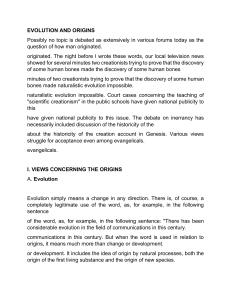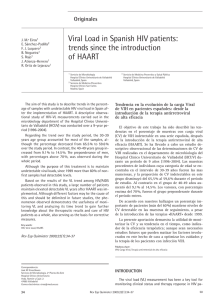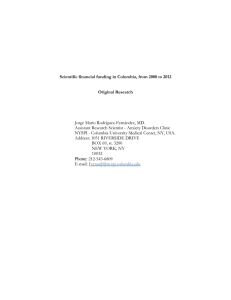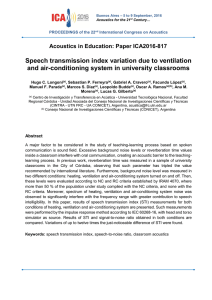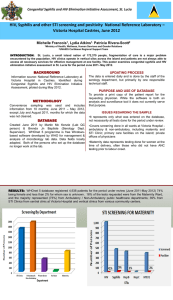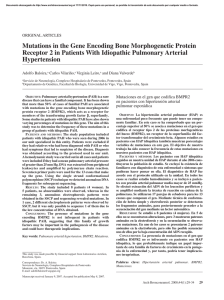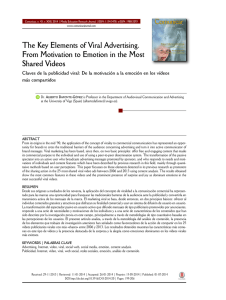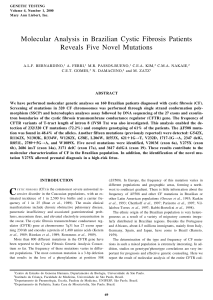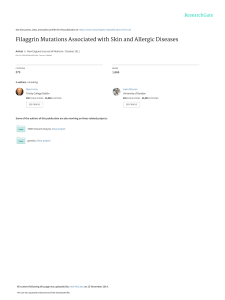Mutations Related to Antiretroviral Resistance Identified by
Anuncio
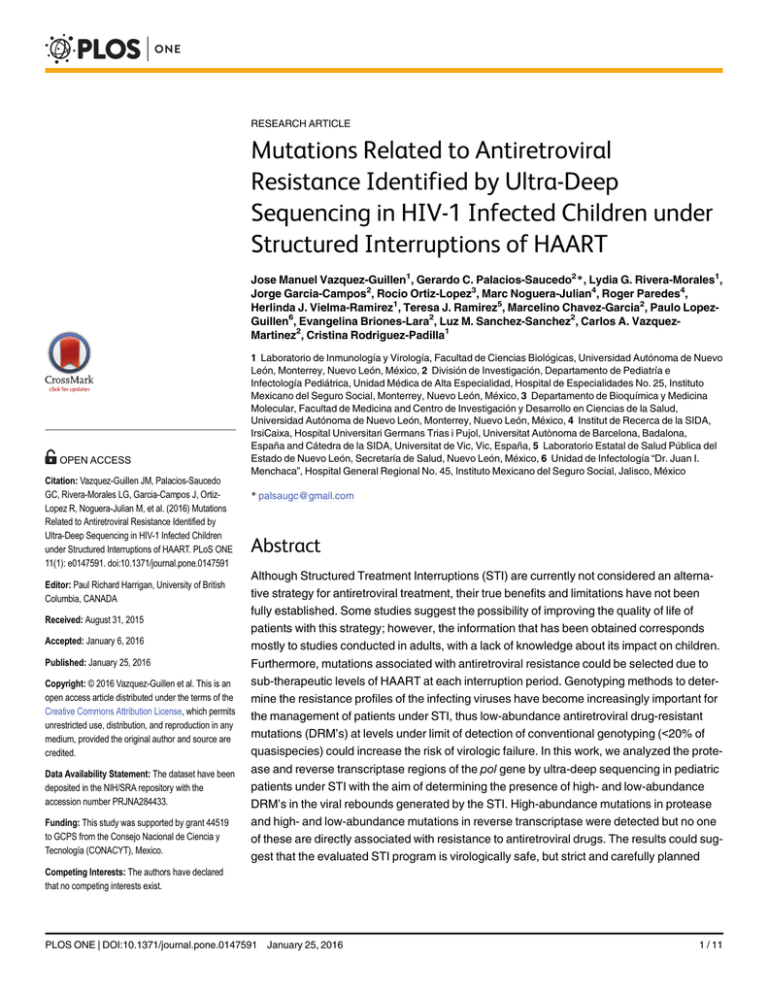
RESEARCH ARTICLE Mutations Related to Antiretroviral Resistance Identified by Ultra-Deep Sequencing in HIV-1 Infected Children under Structured Interruptions of HAART Jose Manuel Vazquez-Guillen1, Gerardo C. Palacios-Saucedo2*, Lydia G. Rivera-Morales1, Jorge Garcia-Campos2, Rocio Ortiz-Lopez3, Marc Noguera-Julian4, Roger Paredes4, Herlinda J. Vielma-Ramirez1, Teresa J. Ramirez5, Marcelino Chavez-Garcia2, Paulo LopezGuillen6, Evangelina Briones-Lara2, Luz M. Sanchez-Sanchez2, Carlos A. VazquezMartinez2, Cristina Rodriguez-Padilla1 OPEN ACCESS Citation: Vazquez-Guillen JM, Palacios-Saucedo GC, Rivera-Morales LG, Garcia-Campos J, OrtizLopez R, Noguera-Julian M, et al. (2016) Mutations Related to Antiretroviral Resistance Identified by Ultra-Deep Sequencing in HIV-1 Infected Children under Structured Interruptions of HAART. PLoS ONE 11(1): e0147591. doi:10.1371/journal.pone.0147591 Editor: Paul Richard Harrigan, University of British Columbia, CANADA Received: August 31, 2015 Accepted: January 6, 2016 Published: January 25, 2016 Copyright: © 2016 Vazquez-Guillen et al. This is an open access article distributed under the terms of the Creative Commons Attribution License, which permits unrestricted use, distribution, and reproduction in any medium, provided the original author and source are credited. Data Availability Statement: The dataset have been deposited in the NIH/SRA repository with the accession number PRJNA284433. Funding: This study was supported by grant 44519 to GCPS from the Consejo Nacional de Ciencia y Tecnología (CONACYT), Mexico. 1 Laboratorio de Inmunología y Virología, Facultad de Ciencias Biológicas, Universidad Autónoma de Nuevo León, Monterrey, Nuevo León, México, 2 División de Investigación, Departamento de Pediatría e Infectología Pediátrica, Unidad Médica de Alta Especialidad, Hospital de Especialidades No. 25, Instituto Mexicano del Seguro Social, Monterrey, Nuevo León, México, 3 Departamento de Bioquímica y Medicina Molecular, Facultad de Medicina and Centro de Investigación y Desarrollo en Ciencias de la Salud, Universidad Autónoma de Nuevo León, Monterrey, Nuevo León, México, 4 Institut de Recerca de la SIDA, IrsiCaixa, Hospital Universitari Germans Trias i Pujol, Universitat Autònoma de Barcelona, Badalona, España and Cátedra de la SIDA, Universitat de Vic, Vic, España, 5 Laboratorio Estatal de Salud Pública del Estado de Nuevo León, Secretaría de Salud, Nuevo León, México, 6 Unidad de Infectología “Dr. Juan I. Menchaca”, Hospital General Regional No. 45, Instituto Mexicano del Seguro Social, Jalisco, México * [email protected] Abstract Although Structured Treatment Interruptions (STI) are currently not considered an alternative strategy for antiretroviral treatment, their true benefits and limitations have not been fully established. Some studies suggest the possibility of improving the quality of life of patients with this strategy; however, the information that has been obtained corresponds mostly to studies conducted in adults, with a lack of knowledge about its impact on children. Furthermore, mutations associated with antiretroviral resistance could be selected due to sub-therapeutic levels of HAART at each interruption period. Genotyping methods to determine the resistance profiles of the infecting viruses have become increasingly important for the management of patients under STI, thus low-abundance antiretroviral drug-resistant mutations (DRM’s) at levels under limit of detection of conventional genotyping (<20% of quasispecies) could increase the risk of virologic failure. In this work, we analyzed the protease and reverse transcriptase regions of the pol gene by ultra-deep sequencing in pediatric patients under STI with the aim of determining the presence of high- and low-abundance DRM’s in the viral rebounds generated by the STI. High-abundance mutations in protease and high- and low-abundance mutations in reverse transcriptase were detected but no one of these are directly associated with resistance to antiretroviral drugs. The results could suggest that the evaluated STI program is virologically safe, but strict and carefully planned Competing Interests: The authors have declared that no competing interests exist. PLOS ONE | DOI:10.1371/journal.pone.0147591 January 25, 2016 1 / 11 Drug Resistance Mutations in STI in Children by Ultra-Deep Sequencing studies, with greater numbers of patients and interruption/restart cycles, are still needed to evaluate the selection of DRM’s during STI. Introduction Highly Active Antiretroviral Therapy (HAART) has been a significant advance for the treatment of HIV infection; however, problems that emerge during its administration, such as chronic toxicity, poor adherence and costs, are factors contributing to treatment failure and limiting its long-term success. Recently, evaluation of Structured Treatment Interruptions (STI) has been proposed as an alternative therapeutic strategy to reduce complications associated with continuous HAART administration [1]. Based on the establishment of treatment periods followed by drug-free periods long enough to allow significant viral rebound but with a controlled maintenance of the viral replication [2], STI could induce an increase of the HIVspecific immune response and, consequently, progressively smaller viral rebounds [3, 4]. However, information available about STI in pediatric patients remains limited and such information in adults is still controversial. The emergence of drug-resistance continues to be a major risk for the STI strategy and it is suspected that low serum levels of antiretroviral drugs during the viral rebounds could be selecting for drug-resistant HIV variants [5, 6]. Mutations associated with drug resistance are usually detected through standard sequencing; however, the quasispecies nature of HIV-1 complicates the detection of low-abundance drug-resistant mutations (DRM’s) [7, 8]. Quasispecies carrying DRM’s at levels <20% of the viral population can outgrow under selective pressure exerted by sub-therapeutic levels of the drug, becoming the major virus population and subsequently leading to therapy failure [9, 10]. The aim of this study was to evaluate the presence of both low-abundance and high-abundance (20% of viral quasispecies) DRM’s by ultra-deep sequencing in viral rebounds of two HIV-1-infected pediatric patients who underwent a STI program of HAART. Materials and Methods Patients and STI program Two HIV-1 infected children with a viral load (VL) undetectable by HAART (<400 copies/ ml), without immunosuppression according to the 1994 CDC classification [11] and HIV asymptomatic for at least the last twelve months were submitted to a STI program. HAART was interrupted for 4 weeks followed by 12 weeks on treatment, until completion of three interruption/restart cycles (4 weeks off/12 weeks on) as previously described [4, 6]. The VL, CD4+ and CD8+ cell counts as well as the clinical status of the patients were evaluated after each interruption period and at 6 and 12 weeks after HAART was restarted. VL was assessed using the Cobas Amplicor HIV-1 Monitor test, version 1.5 (Roche Diagnostics, Branchburg, NJ, USA), the detection limit of which is 400 copies/ml. Lymphocyte counts were measured by standard flow cytometry using the BD Standard Simultest / IMK Lymphocyte Kit (BD Biosciences, San Jose, CA, USA). The study was approved by the research ethics committee at the Hospital de Especialidades No. 25 of the Instituto Mexicano del Seguro Social and written informed consent from the parents or guardians of each patient was obtained. Amplicon generation and preparation of library for ultra-deep sequencing Viral RNA was isolated from plasma samples collected at the end of each HAART interruption period (viral rebound) using the MagMax Viral RNA Isolation kit (Ambion, Foster City, PLOS ONE | DOI:10.1371/journal.pone.0147591 January 25, 2016 2 / 11 Drug Resistance Mutations in STI in Children by Ultra-Deep Sequencing Table 1. Primers with 454-Adaptors (A and B) used to amplify the overlapping protease- and reverse-transcriptase coding regions. Amplicon 1 st 2nd 3rd 4th 5th a b Primer Name UNIV-A / UNIV-B + HXB2 Complementary Sequencea HXB2 Position Tm (°C)b Par1F GTAAAACGACGGCCAGcccaccagaagagagcttca 2160–2180 60.5 Par1R CAGGAAACAGCTATGACtttaacttttgggccatcca 2595–2615 60.3 Par2F GTAAAACGACGGCCAGtagggggaattggaggtttt 2392–2412 59.6 Par2R CAGGAAACAGCTATGACtgcatcacccacatccagta 2872–2891 61.0 Par3F GTAAAACGACGGCCAGggcctgaaaatccatacaatac 2701–2722 57.5 Par3R CAGGAAACAGCTATGACgccctatttctaagtcagatccta 3115–3138 57.3 Par4F GTAAAACGACGGCCAGcacagggatggaaaggatca 2998–3017 60.9 Par4R CAGGAAACAGCTATGACtgcccctgcttctgtatttc 3531–3550 60.2 Par5F GTAAAACGACGGCCAGtccttagaggaaccaaagca 3394–3413 57.5 Par5R CAGGAAACAGCTATGACcctgttagctgccccatct 3875–3893 60.2 Upper case letters indicates the Roche 454-Universal Sequence A or B, and lower case letters the complementary region to HXB2 reference sequence. The Tm corresponds only for the complementary sequence with the HXB2 reference. doi:10.1371/journal.pone.0147591.t001 CA, USA). Reverse transcription was performed with Super Script III First-Strand Synthesis System (Invitrogen, Carlsbad, CA, USA) and random hexamer primers according to manufacturer’s instructions. Using the HXB2 reference sequence (GenBank K03455.1), a set of five pairs of primers was designed to amplify overlapping regions of the protease and the first 1,348 nucleotides of the reverse transcriptase. Each one consisted of the Universal Sequence 454, A or B, at its 5' end required for labeling the amplicons of each sample prior to the emulsion-PCR reaction (emPCR) and the complementary region to the HIV-1 sequence at the 3' end (Table 1). The amplification reactions were performed independently with the cDNA from each sample as template using the Platinum PCR SuperMix High Fidelity (Invitrogen, Carlsbad, CA, USA). Temperatures in the thermocycler were 94°C for 2 min, followed by 40 cycles of 94°C for 15 sec, 54–58°C for 20 sec and 68°C for 1 min. In addition, a final extension period of 68°C for 4 min was programmed. All amplicons were analyzed using the Agilent DNA chips 12,000 Kit (Agilent Technologies, Santa Clara, CA, USA) to assess their approximate concentration, size and purity. Equimolar mixtures of the five amplicons for each viral rebound sample were prepared. Subsequently, for the removal of oligonucleotide dimers we used the Pippin Prep (Sage Science, Beverly, MA, USA) with 2% agarose gels, and fragments over 400 bp were recovered through electroelution. Amplicons were purified with 1.8 volumes of Agentcurt Ampure XP (Beckman Coulter, Beverly, MA, USA) and evaluated with the Agilent DNA chip 12,000. Each amplicon mixture was processed in a second amplification reaction to add the fusion primers containing the Adapter sequence from Roche-454, the molecular identifier (MID) tags in both sense and anti-sense primers and 454-Universal A/B Sequence at its 3’ end (Integrated DNA Technologies Inc., Coralville, IA, USA) (Table 2). The temperatures programmed in the thermocycler were 94°C for 1 min and 6 cycles of 94°C for 30 sec, 55°C for 30 sec and 68°C for 1 min, with a final extension step at 68°C for 2 min. Products from second amplification, containing the five labeled amplicons for each sample, were purified with 1.8 volumes Ampure XP Agentcurt, evaluated with DNA Agilent 12,000 chips and quantified using Quant-iT PicoGreen dsDNA Assay Kit (Invitrogen). Finally, an equimolar mixture of the labeled amplicons was made to generate a library in stock concentration of 1 x 109 molecules/μL and a working dilution of 1 x 107 molecules/μL was prepared. For the emPCR, a 0.66:1 ratio of library molecules was mixed with DNA capture beads following the emPCR LibA protocol from Roche (Roche Company 454 Life Sciences, Branford, USA). The enriched PLOS ONE | DOI:10.1371/journal.pone.0147591 January 25, 2016 3 / 11 Drug Resistance Mutations in STI in Children by Ultra-Deep Sequencing Table 2. Complete sequence of the 454-fusion primers used for the second amplification in library preparation for ultra-deep sequencing. Complete Sequence (5' > 3') Patient (STI) MIDa Name Adaptor A / B Key MID Univ-A / Univ-B 1 (1st) GS-MID03 Adapter-MID03-U-F cgtatcgcctccctcgcgcca tcag agacgcactc gtaaaacgacggccag Adapter-MID03-U-R ctatgcgccttgccagcccgc tcag agacgcactc caggaaacagctatgac 1 (2nd) GS-MID04 Adapter-MID04-U-F cgtatcgcctccctcgcgcca tcag agcactgtag gtaaaacgacggccag Adapter-MID04-U-R ctatgcgccttgccagcccgc tcag agcactgtag caggaaacagctatgac 1 (3rd) 2 (1st) GS-MID05 GS-MID08 2 (2nd) GS-MID09 2 (3rd) GS-MID10 a Adapter-MID05-U-F cgtatcgcctccctcgcgcca tcag atcagacacg gtaaaacgacggccag Adapter-MID05-U-R ctatgcgccttgccagcccgc tcag atcagacacg caggaaacagctatgac Adapter-MID08-U-F cgtatcgcctccctcgcgcca tcag ctcgcgtgtc gtaaaacgacggccag Adapter-MID08-U-R ctatgcgccttgccagcccgc tcag ctcgcgtgtc caggaaacagctatgac Adapter-MID09-U-F cgtatcgcctccctcgcgcca tcag tagtatcagc gtaaaacgacggccag Adapter-MID09-U-R ctatgcgccttgccagcccgc tcag tagtatcagc caggaaacagctatgac Adapter-MID10-U-F cgtatcgcctccctcgcgcca tcag tctctatgcg gtaaaacgacggccag Adapter-MID10-U-R ctatgcgccttgccagcccgc tcag tctctatgcg caggaaacagctatgac Molecular identifier tag from Roche 454 Amplicon Fusion Primer Design. doi:10.1371/journal.pone.0147591.t002 DNA-capture beads were sequenced in GS Junior Titanium Series equipment (Roche) following manufacturer's instructions. Sequencing Analysis The sequencing analysis was made using the GS-Amplicon Variant Analyzer (AVA) software (v 2.8.0). Sequences were demultiplexed using either 5’ or 3’ MID barcodes. AVA was then used to generate alignments based on error corrected consensus reads for each sample. An inhouse perl code was used to call variants at the codon level. A minimal coverage of 500 reads per position was required for further analysis to ensure maximal probability of detecting lowabundance DRM’s. In addition, according to sequencing strand-dependent homopolymer related error patterns and routine negative control results, only those variants showing frequency values on forward and reverse reads within a 1 Log ratio and an overall frequency greater than 1.0% were considered true variants and used for downstream analysis. A variant list containing all drug resistant mutations was reported in the Stanford HIV Drug Resistance Database algorithm (HIVdb, version 6.3.1, updated 09/20/13) through the HIVdb Sierra interface. Definition of low-abundance and high-abundance drug resistance mutations For the purpose of discussion in this paper, we used the term “low-abundance” DRM’s to define mutation that can be detected at <20% of viral quasispecies and “high-abundance” DRM’s as mutations detected at 20% of viral quasispecies through ultra-deep sequencing [8]. Results Patient characteristics Two children were included in the study. Patient No. 1 was a 13.9 year-old female with immune category B3. Patient No. 2 was a 15 year-old male with immune category B2. Both patients acquired HIV-1 infection perinatally and they were receiving zidovudine (AZT) + lamivudine PLOS ONE | DOI:10.1371/journal.pone.0147591 January 25, 2016 4 / 11 Drug Resistance Mutations in STI in Children by Ultra-Deep Sequencing Table 3. Baseline characteristics of two HIV-1 infected children included in a structured treatment interruption (STI) program of HAART. Patient No. 1 Age (years) Sex Patient No. 2 13.9 15 Female Male Previous ART (months) AZT+3TC+RTV (40) AZT+3TC+RTV (40) HAART regimena (months) Combivir+RTV (48) Combivir+Kaletra (38) <400 copies/mL <400 copies/mL (<2.6 log10/mL) (<2.6 log10/mL) Clinical-immune categoryb B3 B2 HIV-1 subtypec B B Viral load ART, Antiretroviral treatment; HAART, Highly Active Antiretroviral Therapy; AZT, Zidovudine; RTV, Ritonavir; 3TC, Lamivudine. At the beginning of the Structured Treatment Interruption program. a b According to the 1994 Centers for Disease Control and Prevention (CDC) classification [11]. c Determined by the computer program REGA HIV-1 Subtyping Tool and reported in a previous study [4]. doi:10.1371/journal.pone.0147591.t003 (3TC) plus ritonavir (RTV) as a HAART regimen at the recommended pediatric dosages. Fulldose RTV as the only protease inhibitor (PI) was still recommended for the initial HAART regimen in children in Mexico at the time this study began (Table 3). Response to the STI program There were no symptoms related to HIV infection and no adverse events related to HAART were observed during the follow-up of the patients. In both patients, the third viral rebound was significantly lower than first and second. VL always fell under detection limits after the therapy was restarted. According to the absolute CD4+ T-Cell counts, Patient No. 1 experienced moderated immunosuppression at the second interruption period (361 cells/ml); however, subsequently counts of these cells tended to increase reaching 791 at the end of follow up. Patient No. 2 experienced severe immunosuppression at the first interruption period (147 cells/ml), but it was transitory reaching afterwards CD4+ T-Cell counts similar than baseline (Table 4). Sequencing analysis and drug resistance interpretation Amplicons covering part of the nucleotide sequences of the pol gene, including the complete protease-coding region (residues 1–99) and part of the reverse transcriptase-coding region (residues 1–448) were analyzed in the viral rebounds generated in patients during interruption periods of the STI program. The dataset have been deposited in the NIH/SRA repository with the accession number PRJNA284433. Genotypes for resistance prediction were obtained using the HIVdb of the Stanford University [12]. No mutations for major or minor resistance to PI were found, and the analysis indicates susceptibility to all PI currently in clinical use. All mutations in the protease region that were detected corresponded to high-abundance DRM’s as they occurred in average frequency values of both forward and reverse coverage close to 100% of the reads. Additionally, mutations that are associated with resistance to nucleoside reverse transcriptase inhibitors (NRTI) or non-nucleoside reverse transcriptase inhibitors (NNRTI) were found. The mutation K101E was detected in the three viral rebounds of Patient No. 1 and V108I was detected only at the third viral rebound of this patient. These mutations are associated to NNRTI resistance and were found as low-abundant DRM’s (< 20%). In Patient No. 2, PLOS ONE | DOI:10.1371/journal.pone.0147591 January 25, 2016 5 / 11 Drug Resistance Mutations in STI in Children by Ultra-Deep Sequencing Table 4. Viral load and T lymphocytes counts of HIV-1 infected children included in a structured treatment interruption program of HAART. Patient Time of follow-up Months Weeks -12 -6 0 4 10 st 1 STI HAART 16 HAART 20 nd 2 STI 26 32 HAART 36 3 rd 42 STI 48 HAART No. 1 VL <400 <400 <400 9730 <400 <400 10500 135 <400 2660 <400 VL Log10 <2.6 <2.6 <2.6 3.99 <2.6 <2.6 4.02 2.13 <2.6 3.42 <2.6 <400 <2.6 CD4+ % 51% 56% 53% 43% 35.3% 46.6% 20.3% 30.4% 25.6% 22.5% 24.2% 28.1% Absolute CD4+ 1157 1241 1255 412 719 749 361 895 807 465 549 791 Absolute CD8+ 1368 1778 1561 997 987 1586 840 1161 1419 819 905 1157 <400 No. 2 VL <400 <400 <400 52900 723 <400 88800 <400 <400 24200 <400 VL Log10 <2.6 <2.6 2.08 4.72 2.86 <2.6 4.95 <2.6 <2.6 4.38 <2.6 <2.6 CD4+ % 61% ND 35% 4.9% 33.8% 14.3% 24.2% 14.3% 26.3% 30.4% 31% 23% Absolute CD4+ 1022 923 560 147 723 345 536 345 478 493 528 473 Absolute CD8+ 611 616 523 2055 600 1566 571 1566 669 599 624 735 HAART: Highly Active Antiretroviral Therapy; STI: Structured Treatment Interruption; VL: Viral Load; ND: Not determined. doi:10.1371/journal.pone.0147591.t004 the E138A mutation was detected at high-abundance (> 99% of the reads) in the three viral rebounds. V90I was detected in the first viral rebound as a high-abundance DRM’s but in the second and third rebound it was detected as a low-abundance. V106I was detected only in the first viral rebound and A62V emerged at the third viral rebound of this patient. The A62V mutation is associated to NRTI resistance; all of the others found are related to NNRTI resistance (Table 5). Discussion Antiretroviral drugs represent a significant progress in the treatment of HIV infection; however, problems that emerge during their administration limit their long-term benefits [13]. In pediatric patients, the burden of chronic treatment is the most common reason for treatment interruption; however, other side effects, such as the development of physiological problems, are involved directly with treatment adherence [14, 15]. As a result, STI has been proposed as an alternative to continuous HAART, since they have the potential to reduce problems of chronic toxicity and adherence to treatment [4]. Because the progression of HIV-related illness is often faster in children than in adults, it has not been conclusively shown whether strategies based on the interruption of treatment may also work in the pediatric population, and therefore the information available for these patients is limited [2, 4, 16]. In a previous study by our research group [4], four children with HIV-1 infection under virological control were subjected to a scheme of STI in order to assess its immunological and clinical impact. The HAART of each child was interrupted for 4 weeks, followed by 12 weeks under treatment, until three interruption/restart cycles were completed. In all four patients, progressively lower viral rebounds were observed with a vigorous development of T CD8+ cells and an initial decrease in the response of T-helper cells, followed by a subsequent increase. In a second study, using a standard genotyping analysis and the HIVdb [12], the sequences codifying for the protease and reverse transcriptase were analyzed in samples corresponding to the viral rebounds of the STI program, finding no resistance to any of the PI or reverse PLOS ONE | DOI:10.1371/journal.pone.0147591 January 25, 2016 6 / 11 Drug Resistance Mutations in STI in Children by Ultra-Deep Sequencing Table 5. Drug resistance interpretation of low-abundance and high-abundance mutations detected by ultra-deep sequencing in two HIV-1 infected children underwent a structured treatment interruption program of HAART. Mutation FreqAvg (%)a PI I93L 100 PI L63P 100 PI V77I 100 NNRTI K101E 1.86 PI I93L 100 PI L63P 100 PI V77I 99.94 PI I93L 100 PI L63P 100 PI V77I 99.90 NNRTI V108I 2.59 NNRTI K101E 1.01 PI L63P 99.69 99.45 Patient STI Class No. 1 1st 2nd 3rd No. 2 1st PI I64V NNRTI E138A 100 NNRTI V106I 23.74 NNRTI V90I 93.74 PI I64V 100 PI L63P 99.34 NNRTI E138A 100 PI L63P 100 97.40 2nd 3rd PI I64V NRTI A62V 1.72 NNRTI E138A 99.72 NNRTI V90I 14.61 a Frequency average in 90,000 reads. b HIVdb Genotyping resistance interpretation algorithm. STI, Structured Treatment Interruption; PI, Protease inhibitor; NRTI, Nucleoside Reverse Transcriptase Inhibitor; NNRTI, Non-Nucleoside Reverse Transcriptase Inhibitor. doi:10.1371/journal.pone.0147591.t005 transcriptase inhibitors commercially available [6]. Despite the limitations of the number of patients analyzed, the results of that previous work suggested that STI, in the context evaluated, could be safe; however, before suggesting new research in different populations of children, it is necessary to consider the genetic heterogeneity of the viral subpopulations during HIV infection and to assess the presence or absence of mutations associated with antiretroviral resistance even in minority viral populations infecting a patient. In effect, the natural tendency to errors of the reverse transcriptase, combined with the high viral replication activity, result in the generation of genetically related viral variations called quasispecies with important implications on the dynamics of the infection [17]. Moreover, one of the major limitations of standard genotyping tests is their inability to detect quasispecies that occur in less than 20–25% of the circulating viral population in a patient [10]. These subpopulations in low-abundance can lead to mutations associated with antiretroviral resistance and can develop rapidly to become predominant under conditions of selective pressure which eventually lead to therapeutic failure [18]. An alternative to identify these minority variants is the use of ultra-deep sequencing, also known as next-generation sequencing (NGS) technologies [19, 20, 21, 22]. The possibility of detecting mutations associated with resistance to antiretrovirals drugs of various viral PLOS ONE | DOI:10.1371/journal.pone.0147591 January 25, 2016 7 / 11 Drug Resistance Mutations in STI in Children by Ultra-Deep Sequencing quasispecies, including those of low-abundance is the main advantage of the ultra-deep sequencing over the traditional Sanger method. In this work, ultra-deep sequencing was used in a short amplicon design to assess the selection of mutations associated with antiretroviral resistance during viral rebounds of two children with chronically undetectable VL included in a STI schedule of 4 weeks off / 12 weeks on HAART. The L63P, V77I, and I93L mutations in the protease region were found in patient No. 1 and L63P and I64V in patient No 2. The HIVdb genotypic resistance interpretation algorithm classifies these mutations as “other mutations” and refers them as accessory mutations. Such mutations are not associated with antiretroviral resistance. The L63P mutation is a common polymorphism in patients receiving PI; V77I is a common polymorphism associated with treatment with Nelfinavir (NFV) and the I93L mutation is also a common polymorphism associated with PI therapy in subtype B viruses. The HIVdb does not show comment for the I64V mutation. However, resistance mutations in the protease gene are classified as “major” or “minor” in the 2014 Update of the Drug Resistance Mutation in HIV-1 from the International Antiviral Society-USA (IAS-USA) [23]. According to the IAS-USA list, all the mutations in protease region of our patients are defined as minor resistance mutations. L63P is associated with Lopinavir (LPV) minor resistance; V77I with NFV, Indinavir (IDV), and Saquinavir (SQV) minor resistance; I93L and I64L are related to minor resistance against Atazanavir (ATV). The minor mutations do not have a substantial effect on the phenotype and often are generally considered to be accessory mutations but they may improve replication of viruses containing major mutations [23]. Comparing viral rebounds in each patient, it was observed that substitutions in the protease-coding region were the same in each rebound, it may thus be suggested that selection of new mutations was not induced during the three periods of interruption/resumption. Instead, mutations detected in the protease may have been present before the STI scheme was initiated although it is hard to make correct interpretations of the data without a baseline sequence prior to the STI program. These mutations were also found in the previous study using standard genotyping to assess the effect of the STI [6]. Additionally, another study also reported the presence of these changes in naïve patients [24]. In the present work, the mutations in the protease were always detected as a high-abundance and variation in their frequency never was shown (Table 5). These observations may suggest that the STI program, as planned in this study, could be safe by not selecting mutations associated with resistance to PI. On the other hand, several mutations associated with low-level or intermediate-level resistance to NNRTI were found in the viral rebounds of both patients. In two viral rebounds of patient No. 1, the K101E mutation was found, which causes intermediate resistance to Nevirapine (NVP) and low-level resistance to Efavirenz (EFV) and Etravirine (ETR) and, in combination with M184I, causes intermediate resistance to Rilpivirine (RPV). The mutation was maintained at low-abundance and it never surpassed 2% of the reads, despite the cycles of treatment interruption/restart in this patient. In the third rebound of the same patient, the V108I mutation was detected, which is selected by NVP, EFV and ETR and may slightly reduce the susceptibility to NVP and EFV. The E138A mutation detected in the three viral rebounds of patient No. 2 is a common polymorphic change, which can be selected for the treatment with ETR and RPV. This mutation may slightly decrease susceptibility to ETR and RPV. The V90I substitution, found in the first and third viral rebounds of patient No. 2 is a common accessory polymorphism that may be slightly selected for the treatment with NNRTI in vitro and/or in vivo and is associated with minimal or no reduction in the susceptibility to ETR. In the first rebound of this patient, the V106I mutation was detected, which is a polymorphic mutation selected by the EFV therapy and which, in combination with V179D, can reduce susceptibility to NVP and EFV. The A62V mutation, found in the third rebound of patient No. 2, PLOS ONE | DOI:10.1371/journal.pone.0147591 January 25, 2016 8 / 11 Drug Resistance Mutations in STI in Children by Ultra-Deep Sequencing is the only one associated with NRTI resistance but it requires the presence of the changes K65R and Q151M or the T69 insertion to reduce susceptibility to NRTI. Alone, A62V has no effect on the susceptibility to antiretroviral drugs, and although it is indicated as a resistance mutation to NRTI, the viruses that present it are susceptible to all antiretroviral drugs. Since mutations K101E in patient No. 1 and E138A and V90I in patient No. 2 were present from the first period of interruption. It is thus possible that these mutations were not generated during the interruption/restart periods of HAART, but they were already present before patients be included in the study; however, no genotyping study was carried out prior to initiating the STI program to ensure this. In addition, V108I in patient No. 1 and A62V in patient No. 2 emerged as low-abundance DRM’s at the third viral rebound of the STI program, so subsequent evaluations are needed to monitoring the behavior of these mutations. Importantly, the mutations related with resistance to NNRTI detected are generally selected by the treatment with the same NNRTI and both children in our study never received and were not receiving such antiretroviral drugs. In the present study, not any HIV-infection related symptom or HAART related side event was identified, such as we observed in our previous study that included four pediatric patients submitted to the same STI program [4]. Similarly, CD4+ lymphocyte counts fell during periods of treatment interruption but subsequently recovered, and although they not reached baseline levels at final follow-up these counts tended to increasing. Nonetheless, these decreasing in CD4+ lymphocyte counts may cause concerns about the possibility of subsequent development of more immune problems; additional interruption-restart periods were necessary to demonstrate whether these counts rebounded back to levels prior to STI. Because only one event of severe immunosuppression accordingly to the absolute CD4+ T-Cell counts occurred, which was transitory, these results suggest that the risk of loss of control of the immune response with the subsequent development of secondary clinical events is low [3, 4]. In summary, it could be concluded that the STI program did not lead to the development of any meaningful DRM’s which suggests that the detected mutations do not represent a risk for virologic failure during subsequent therapy in patients. Thus, this study highlight the need to continue studies about the impact of STI in pediatric patients with a strict and careful planning and with a greater number of interruption/restart cycles to evaluate the behavior of DRM’s that can emerge. Ethical Approval This study was approved by the institutional research and ethics review board of the Hospital de Especialidades No. 25, Instituto Mexicano del Seguro Social, Monterrey, Mexico. Acknowledgments This study was supported by the grant 44519 from the Consejo Nacional de Ciencia y Tecnología (CONACYT), Mexico. We thank to Ramses Medina-González for his help and collaboration in the technical work of sequencing experiments, to the Laboratorio de Inmunologia y Virologia from Facultad de Ciencias Biologicas UANL for providing all the necessary facilities for the research, and to the Red Tematica de Inmunologia en Cancer y Enfermedades Infecciosas (INMUNOCANEI-CONACYT) for all its collaboration. Author Contributions Conceived and designed the experiments: JMVG GCPS LGRM ROL CAVM CRP. Performed the experiments: JMVG GCPS LGRM ROL HJVR TJR EBL. Analyzed the data: JMVG GCPS PLOS ONE | DOI:10.1371/journal.pone.0147591 January 25, 2016 9 / 11 Drug Resistance Mutations in STI in Children by Ultra-Deep Sequencing LGRM MNJ RP. Contributed reagents/materials/analysis tools: JMVG GCPS JGC MCG LMSS PLG. Wrote the paper: JMVG GCPS LGRM ROL MNJ PLG CAVM CRP. References 1. Kalmar EM, Sanabani SS, Charlys da Costa A, Ferreira S, Barreto CC, Chen S, et al. Evaluation of HIV-1 resistance to antiretroviral drugs among 150 patients after six months of therapeutic interruption. Int J STD AIDS. 2012; 23: 120–125. doi: 10.1258/ijsa.2011.011124 PMID: 22422687 2. Van Rompay KK, Singh RP, Heneine W, Johnson JA, Montefiori DC, Bischofberger N, et al. Structured treatment interruptions with tenofovir monotherapy for simian immunodeficiency virus-infected newborn macaques. J Virol. 2006; 80: 6399–6410. PMID: 16775328 3. Borkowsky W, Yogev R, Muresan P, McFarland E, Frenkel L, Fenton T, et al. Planned multiple exposures to autologous virus in HIV type 1-infected pediatric populations increases HIV-specific immunity and reduces HIV viremia. AIDS Res Hum Retroviruses. 2008 Mar; 24: 401–411. doi: 10.1089/aid.2007. 0110 PMID: 18327977 4. Palacios GC, Sanchez LM, Briones E, Ramirez TJ, Castillo H, Rivera LG, et al. Structured interruptions of highly active antiretroviral therapy in cycles of 4 weeks off/12 weeks on therapy in children having chronically undetectable viral load cause progressively smaller viral rebounds. Int J Infect Dis. 2010; 14: 34–40. 5. Pennings PS. Standing genetic variation and the evolution of drug resistance in HIV. Plos Comput Biol. 2012; 8: e1002527. doi: 10.1371/journal.pcbi.1002527 PMID: 22685388 6. Palacios-Saucedo GC, Rivera-Morales LG, Vazquez-Guillen JM, Sánchez LM, Ramirez TJ, Briones E, et al. Drug resistance mutations during structured interruptions of HAART in HIV-1 infected children. Curr HIV Res. 2011; 9: 154–159. PMID: 21457133 7. Alteri C, Santoro MM, Abbate I, Rozera G, Bruselles A, Bartolini B, et al. ‘Sentinel’ mutations in standard population sequencing can predict the presence of HIV-1 reverse transcriptase major mutations detectable only by ultra-deep pyrosequencing. J Antimicrob Chemother. 2011; 66: 2615–2623. doi: 10.1093/ jac/dkr354 PMID: 21890537 8. Le T, Chiarella J, Simen BB, Hanczaruk B, Egholm M, Landry ML, et al. Low-abundance HIV drugresistant viral variants in treatment-experienced persons correlate with historical antiretroviral use. Plos One. 2009; 4: e6079. doi: 10.1371/journal.pone.0006079 PMID: 19562031 9. Metzner KJ, Bonhoeffer S, Fischer M, Karanicolas R, Allers K, Joos B, et al. Emergence of minor populations of human immunodeficiency virus type 1 carrying the M184V and L90M mutations in subjects undergoing structured treatment interruptions. J Infect Dis. 2003; 188: 1433–1443. PMID: 14624368 10. Metzner KJ, Giulieri SG, Knoepfel SA, Rauch P, Burgisser P, Yerly S, et al. Minority quasispecies of drug-resistant HIV-1 that lead to early therapy failure in treatment-naive and -adherent patients. Clin Infect Dis. 2009; 48: 239–247. doi: 10.1086/595703 PMID: 19086910 11. Centers for Disease Control and Prevention (CDC). 1994 Revised classification system for human immunodeficiency virus infection in children less than 13 years of age. MMWR Recomm Rep. 1994; 43 (RR-12): 1–10. 12. Rhee SY, Gonzales MJ, Kantor R, Betts BJ, Ravela J, Shafer RW. Human immunodeficiency virus reverse transcriptase and protease sequence database. Nucleic Acids Res. 2003; 31: 298–303. PMID: 12520007 13. Lori F, Maserati R, Foli A, Seminari E, Timpone J, Lisziewicz J. Structured treatment interruptions to control HIV-1 infection. Lancet. 2000; 355: 287–288. PMID: 10675080 14. Deeks SG, Wrin T, Liegler T, Hoh R, Hayden M, Barbour JD, et al. Virologic and immunologic consequences of discontinuing combination antiretroviral-drug therapy in HIV-infected patients with detectable viremia. N Engl J Med. 2001; 344: 472–480. PMID: 11172188 15. Saitoh A, Foca M, Viani RM, Heffernan-Vacca S, Vaida F, Lujan-Zilbermann J, et al. Clinical outcomes after an unstructured treatment interruption in children and adolescents with perinatally acquired HIV infection. Pediatrics. 2008; 121: 513–521. 16. Monpoux F, Tricoire J, Lalande M, Reliquet V, Bebine B, Thuret I. Treatment interruption for virological failure or as sparing regimen in children with chronic HIV-1 infection. AIDS. 2004; 18: 2401–2409. PMID: 15622316 17. Lauring AS, Andino R. Quasispecies theory and the behavior of RNA Viruses. Plos Pathog. 2010 Jul 6: e1001005. doi: 10.1371/journal.ppat.1001005 PMID: 20661479 18. O’Meara D, Wilbe K, Leitner T, Hejdeman B, Albert J, Lundeberg J. Monitoring resistance to Human Immunodeficiency Virus type 1 protease inhibitors by pyrosequencing. J ClinMicrobiol. 2001; 39: 464– 473. PLOS ONE | DOI:10.1371/journal.pone.0147591 January 25, 2016 10 / 11 Drug Resistance Mutations in STI in Children by Ultra-Deep Sequencing 19. Wang C, Mitsuya Y, Gharizadeh B, Ronaghi M, Shafer RW. Characterization of mutation spectra with ultra-deep pyrosequencing: application to HIV-1 drug resistance. Genome Res. 2007; 17: 1195–1201. PMID: 17600086 20. Eriksson N, Pachter L, Mitsuya Y, Rhee SY, Wang C, Gharizadeh B, et al. Viral population estimation using pyrosequencing. Plos Comput Biol. 2008; 4: 1–13. 21. Ji H, Masse N, Tyler S, Liang B, Li Y, Merks H, et al. HIV drug resistance surveillance using pooled pyrosequencing. Plos One. 2010 Feb 5: e9263. doi: 10.1371/journal.pone.0009263 PMID: 20174661 22. Hedskog C, Mild M, Jernber J, Sherwood E, Bratt G, Leitner T, et al. Dynamics of HIV-1 quasispecies during antiviral treatment dissected using ultra-deep pyrosequencing. Plos One. 2010 Jul 5: e11345. doi: 10.1371/journal.pone.0011345 PMID: 20628644 23. Wensing AM, Calvez V, Günthard HF, Johnson VA, Paredes R, Pillay D, et al. 2014 Update of the Drug Resistance Mutations in HIV-1. Top Antivir Med. 2014; 22: 642–650. PMID: 25101529 24. Valle-Bahena OM, Ramos-Jimenez J, Ortiz-Lopez R, Revol A, Lugo-Trampe A, Barrera-Saldaña HA, et al. Frequency of protease and reverse transcriptase drug resistance mutations in naïve HIV-infected patients. Arch Med Res. 2006; 37: 1022–1027. PMID: 17045121 PLOS ONE | DOI:10.1371/journal.pone.0147591 January 25, 2016 11 / 11
